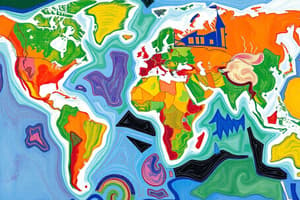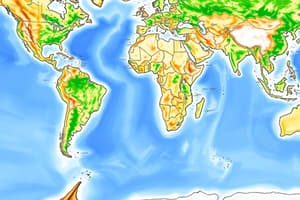Podcast
Questions and Answers
Explain the difference between absolute location and relative location, providing an example of each.
Explain the difference between absolute location and relative location, providing an example of each.
Absolute location refers to a place's precise position on Earth using coordinates like latitude and longitude. For example, the absolute location of the Eiffel Tower in Paris is 48.8584° N, 2.2945° E. Relative location, on the other hand, describes a place based on its proximity to other features. For instance, the Eiffel Tower is located near the Seine River and the Champ de Mars.
Describe two ways in which human activities can impact the environment, providing specific examples.
Describe two ways in which human activities can impact the environment, providing specific examples.
Human activities can significantly impact the environment. One way is through pollution, such as air pollution from factories which increase the Carbondioxide percentage in atmosphere creating the global warming and continously increasing the earth's temperature or water pollution from industrial waste results in decreasing in amount of availability of fresh water.This can harm ecosystems and human health. Another way is through deforestation, where large-scale tree clearing for agriculture, urbanization, or logging can lead to soil erosion, habitat loss, and climate change, decrease in rainfall which disturb the balance of earth's environment.
Explain how Geographic Information Systems (GIS) can be used in environmental planning.
Explain how Geographic Information Systems (GIS) can be used in environmental planning.
GIS is a powerful tool for environmental planning. It allows users to collect, analyze, and visualize spatial data, such as land use, population density, and pollution levels. This information can be used to identify areas at risk, model potential impacts, and develop sustainable solutions. For example, GIS can map areas prone to flooding and help planners design flood mitigation strategies.
What are the main differences between physical geography and human geography, and how do these branches of geography interact?
What are the main differences between physical geography and human geography, and how do these branches of geography interact?
Why is it important to consider different scales of analysis when studying geographical phenomena?
Why is it important to consider different scales of analysis when studying geographical phenomena?
Flashcards
Geography
Geography
The study of the Earth's surface and spatial distribution of phenomena.
Physical Geography
Physical Geography
Focuses on natural processes and features like climate and landforms.
Human Geography
Human Geography
Explores relationships between humans and their environments, like urbanization and culture.
Location
Location
Signup and view all the flashcards
GIS (Geographic Information Systems)
GIS (Geographic Information Systems)
Signup and view all the flashcards
Study Notes
Introduction to Geography
- Geography is the study of the Earth's surface, its features, and the spatial distribution of human and natural phenomena.
- It encompasses both physical and human aspects of the environment.
Branches of Geography
- Physical Geography: Focuses on natural processes and features of the Earth.
- Includes topics like climate, landforms, vegetation, and hydrology.
- Examines the interactions between these elements.
- Human Geography: Explores the relationship between humans and their environments.
- Includes topics like population, urbanization, cultural patterns, economic activities, and political systems.
- Studies how human actions shape the landscape.
- Regional Geography: Examines specific regions of the world, integrating physical and human geographical factors.
- Analyzes unique characteristics of a region and its distinctive features.
Key Concepts in Geography
- Location: Refers to a place's position on the Earth's surface.
- Absolute location uses coordinates (latitude and longitude).
- Relative location describes a place in relation to other locations.
- Place: Encompasses the unique characteristics of a location.
- Includes physical characteristics (e.g., mountains, rivers) and human characteristics (e.g., culture, population).
- Region: An area with shared characteristics.
- Regions can be defined by physical features, cultural traits, or economic activities.
- Human-Environment Interaction: Explores how humans adapt to and modify their environment.
- Movement: Examines the way people, goods, and ideas move across the Earth.
Tools and Techniques in Geography
- Geographic Information Systems (GIS): Software used to capture, store, analyze, and display spatial data.
- Useful for mapping, identifying patterns, and modeling geographical phenomena.
- Remote Sensing: Acquisition of data about Earth's surface from a distance.
- Techniques such as aerial photography and satellite imagery are used.
- Cartography: The art and science of mapmaking.
- Essential for visualizing geographical data.
Scales of Analysis in Geography
- Global: Studies the Earth as a whole.
- Examining global patterns in climate, population, and economic activity.
- Regional: Focuses on specific large areas.
- Analyzing characteristics of continents, countries, or large regions.
- Local: Investigates smaller areas.
- Examining urban areas, specific neighborhoods, or countries.
Geographic Skills
- Map Reading: Interpreting different types of maps; understanding symbols and scale.
- Data Analysis: Interpreting statistical data related to geographical patterns.
- Spatial Thinking: Understanding the significance of location and spatial relationships.
- Critical Thinking: Developing awareness of the influence of geography on human decisions.
Applications of Geography
- Urban Planning: Using geographical knowledge to design and manage urban areas.
- Environmental Management: Using GIS to understand and address environmental issues.
- Resource Management: Employing geographical information to manage natural resources.
- Public Health: Utilizing geographic insights for community health programs.
- Disaster Management: Studying the spatial impacts of natural disasters.
Studying That Suits You
Use AI to generate personalized quizzes and flashcards to suit your learning preferences.




